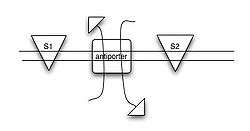Antiporter

An antiporter (also called exchanger or counter-transporter) is a cotransporter and integral membrane protein involved in secondary active transport of two or more different molecules or ions across a phospholipid membrane such as the plasma membrane in opposite directions. Na+/H+ antiporters have been reviewed.[1]
In secondary active transport, one species of solute moves along its electrochemical gradient, allowing a different species to move against its own electrochemical gradient. This movement is in contrast to primary active transport, in which all solutes are moved against their concentration gradients, fueled by ATP.
Transport may involve one or more of each type of solute. For example, the Na+/Ca2+ exchanger, used by many cells to remove cytoplasmic calcium, exchanges one calcium ion for three sodium ions.
See also
References
- ↑ Padan, Etana; Landau, Meytal (2016). "Chapter 12. Sodium-Proton (Na+/H+) Antiporters: Properties and Roles in Health and Disease". In Astrid, Sigel; Helmut, Sigel; Roland K.O., Sigel. The Alkali Metal Ions: Their Role in Life. Metal Ions in Life Sciences. 16. Springer. pp. 391–458. doi:10.1007/978-3-319-21756-7_12.
External links
- Antiporters at the US National Library of Medicine Medical Subject Headings (MeSH)
- Pak, J. E.; Ekende, E. N.; Kifle, E. G.; et al. (Nov 12, 2013). "Structures of intermediate transport states of ZneA, a Zn(II)/proton antiporter". Proc Natl Acad Sci U S A. 110 (46): 18484–18489. doi:10.1073/pnas.1318705110. PMC 3832018. PMID 24173033.